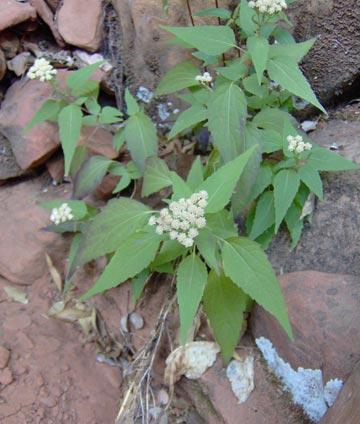|
Family: Asteraceae |
Perennials, subshrubs, or shrubs [trees], mostly 20-220 cm. Stems usually erect, rarely scandent, sparsely to densely branched. Leaves cauline; mostly opposite (distal sometimes alternate); petiolate; blades 3(-5)-nerved from bases, usually deltate, lanceolate, ovate, rhombic, or triangular, sometimes orbiculate, margins entire, crenate, dentate, or serrate, faces glabrous or hispidulous, pilose, or puberulent, sometimes gland-dotted (A. occidentalis, A. adenophora). Heads discoid, usually in compact, (terminal and axillary) corymbiform arrays, sometimes borne singly. Involucres campanulate, 3-6 mm diam. Phyllaries persistent, 8-30 in 2(-3) series, 0- or 2-nerved, lanceolate to linear, ± equal (herbaceous). Florets 10-60; corollas white or lavender, throats obconic to campanulate (lengths 1.5-2 times diams.); styles: bases sometimes enlarged, glabrous, branches linear, seldom distally dilated. Receptacles convex (glabrous or hairy), epaleate. Cypselae prismatic or ± fusiform, usually 5-ribbed, scabrellous and/or gland-dotted; pappi usually persistent, sometimes fragile, rarely falling, of 5-40, barbellulate bristles in 1 series. x = 17. |


